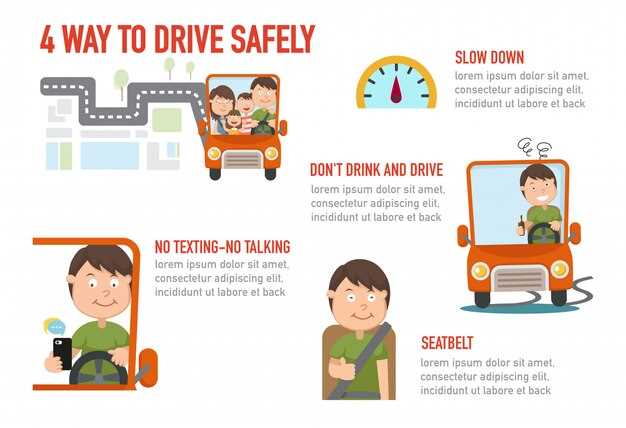
Embarking on a long-distance trip can be both exciting and challenging. The open road offers the promise of adventure, but it also poses unique risks, particularly when it comes to driving fatigue. Understanding how to manage these risks is crucial for ensuring a safe journey.
Fatigue is one of the leading causes of accidents on highways. As drivers cover extensive distances, the monotony of the road can lead to decreased alertness and slower reaction times. To combat fatigue, it’s essential to incorporate smart strategies into your travel plans. By prioritizing rest and staying mindful of your own limits, you can help ensure that you arrive at your destination safely.
In this article, we will explore key tips and strategies that can enhance your safety while driving long distances. From the importance of regular breaks to practical ways to stay engaged, these insights will help you maintain focus and energy throughout your trip. Let’s dive into these smart driving tips to make your next highway journey both enjoyable and secure.
Recognizing and Managing Driver Fatigue During Road Trips
Driver fatigue is a significant risk factor during long-distance travel. Understanding the symptoms and implementing effective management strategies can greatly enhance safety on the road.
Recognizing the Signs: It’s crucial to be aware of the warning signs of fatigue. Common indicators include frequent yawning, difficulty concentrating, blurred vision, and moments of micro-sleep. If you find yourself daydreaming or struggling to maintain a consistent speed, it’s time to evaluate your alertness.
Short Breaks: Plan regular stops every two hours or so. Stretching your legs, walking around, and taking deep breaths can revitalize your energy levels. Use these breaks to hydrate and snack on healthy foods that provide sustained energy.
Sleep Management: Ensure you are well-rested before embarking on a road trip. Aim for at least seven to eight hours of sleep the night before. If you feel tired during your journey, don’t hesitate to pull over for a short nap. Even a 15 to 20-minute nap can help restore alertness.
Traveling with a Partner: Consider sharing the driving responsibilities with another licensed driver. Taking turns behind the wheel allows for longer travel durations without compromising safety, as each driver can rest while the other is in control.
Caffeine as a Temporary Solution: If you are struggling with fatigue, moderate caffeine consumption can provide a temporary boost. However, it should not replace proper rest and breaks. Monitor your intake to avoid over-reliance on stimulants.
Effectively recognizing and managing driver fatigue is essential for safe journeys. By implementing proactive strategies, you can ensure a safer and more enjoyable road trip for yourself and your passengers.
Essential Vehicle Preparations for Long-Distance Travel

Before embarking on a long-distance journey, ensuring your vehicle is in optimal condition is crucial for a safe and enjoyable trip. Begin with a comprehensive inspection of all essential systems, including the engine, brakes, and transmission. A well-maintained engine will mitigate the risk of sudden failures that could lead to fatigue-inducing delays on the road.
Tires play a pivotal role in your vehicle’s performance. Check for proper inflation and adequate tread depth. Under-inflated or worn tires can increase stopping distances and decrease fuel efficiency, leading to unnecessary stops that contribute to driver fatigue. Keep a spare tire and the tools necessary for a quick change should the need arise.
Examine your brake system thoroughly. Listen for unusual noises when applying the brakes, as these may indicate issues that could compromise your safety. Ensuring your brakes are responsive and reliable will help you navigate various road conditions effectively.
Next, inspect your fluid levels, including oil, coolant, brake fluid, and windshield washer fluid. Maintaining appropriate levels will ensure your vehicle operates smoothly and reduces the likelihood of a breakdown during your travels. Additionally, check for any leaks that could exacerbate these issues over time.
Another critical aspect to consider is your battery. Ensure it is securely mounted and free from corrosion. A fully charged and functional battery will prevent unexpected shutdowns and keep your vehicle running consistently on long stretches of road.
Prepare your emergency kit, which should include items such as a first-aid kit, flashlights, water, and non-perishable snacks. These essentials will help you manage any unforeseen circumstances that may arise due to road conditions or fatigue during your trip.
Finally, familiarize yourself with your vehicle’s navigation system or mobile apps prior to departure. Knowing your route and potential rest stops can help you plan breaks effectively, ensuring you remain alert and focused on the road ahead. Proper vehicle preparations combined with resting strategies will enhance your safety and overall experience during long-distance travel.
Creating a Responsible Itinerary to Ensure Safe Driving Breaks

When planning a long-distance road trip, it is essential to create a responsible itinerary that includes scheduled driving breaks. Fatigue can significantly impair your ability to drive safely, making it crucial to take regular intervals to rest and recharge.
Start with a realistic assessment of how many hours you can drive in a day without compromising your concentration. Most experts recommend no more than 8 hours of driving a day, which should be divided into manageable sections of 2 to 3 hours each.
Incorporate designated break times into your itinerary every 2 to 3 hours. Use these breaks to stretch your legs, hydrate, and have nutritious snacks. Avoid heavy meals that can lead to increased fatigue.
Plan stops at rest areas or safe locations where you can safely park your vehicle. Emphasize breaks during the early afternoon and late evening, as these times are when many drivers experience heightened drowsiness.
While on the road, monitor your energy levels closely. If you start to feel tired, it’s important to take an unscheduled break. Consider sharing the driving responsibilities with a passenger to alleviate some of the fatigue.
By systematically creating a thoughtful itinerary that prioritizes rest, you enhance your safety and the experience of everyone on board.



